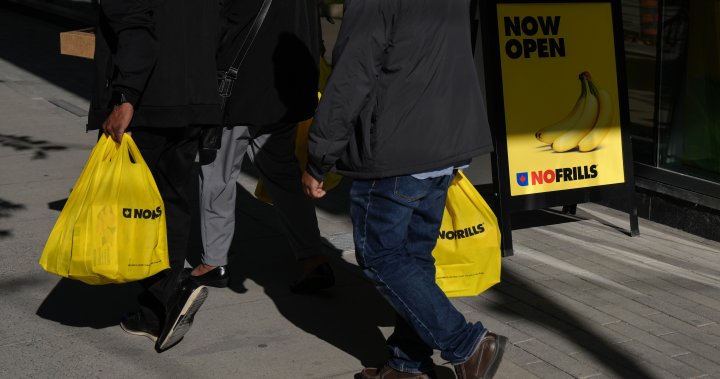Loblaw is testing smaller-format discount stores across the country this year as shoppers increasingly look for ways to save on their grocery bill.
The company has a handful of smaller discount stores already, but plans to “lean in” to the strategy as a way of reaching more customers, said Melanie Singh, who leads Loblaw’s discount division that includes No Frills and Maxi.
“We’re able to offer an entire shop within the space of 10,000 square feet in a pocket of downtown Toronto that we don’t have a hard discount presence in,” she said in an interview at the grand opening of the first store in the rollout. “So we’re super proud of that.”
That store opened on Thursday, one of several slated to open between now and Thanksgiving, said Singh. It’s about one-third of the size of the average No Frills store.
The location used to be a City Market, another banner owned by Loblaw. Four weeks ago, the company closed it down, said Singh, converting it to the No Frills store, which is owned by a franchisee who lives in the area.

These smaller stores will cater to the local neighbourhood, Singh said. For example, this store at the corner of King and Shaw Sts. in Liberty Village has grab-and-go options like fresh-baked pastries, which many discount stores don’t have.
Singh said that’s because the company kept many of the products that were popular in the former City Market, like rotisserie chicken.
The email you need for the day’s
top news stories from Canada and around the world.
“We heard from the neighbourhood that ready-made food was super important. Especially for lunch, especially for the end of the day, for the transient traffic that comes in the afternoon,” she said. “So we kept those programs.”
This move comes as shoppers have been increasingly gravitating toward discount stores and private-label brands to try and mitigate the effects of food inflation. Earnings reports from the major Canadian grocers have shown discount store traffic has been a major driver of sales growth amid this shift.
It’s a timely move by the grocer, said retail analyst Bruce Winder, as consumers are looking for more ways to save.
“There’s a lot of people struggling with cost of living, particularly in the big urban centres,” he said.
Winder thinks introducing more small discount stores will be a popular decision not only right now, but also in the long term.
“Some of the changes we’ve seen from a demographic and spending pattern post-pandemic, I think these are mostly here to stay,” he said.
“I think that these type of discount grocers are important, and they’re going to grow, and they’re going to be popular not just now but in the future because of that, because these are permanent changes to the economics of living in big cities in Canada.”

The grocers have been expanding their discount footprints through both new stores and conversions. Loblaw in February announced a more than $2-billion capital investment plan that it said will result in more than 40 new discount stores.
The shift also comes during a time of increasing frustration from customers over food inflation as grocery prices have jumped by more than 20 per cent over the past three years. The grocers have been under political pressure to try and stabilize prices, and Loblaw has been the target of a boycott for the past month.
Despite the differences between a smaller No Frills and the regular-size stores, all the promotional programs are the same, said Singh.
She noted that recently the company removed “multi-buy” promotions in all No Frills stores after feedback from customers, who said they couldn’t always afford to buy multiples of an item in order to get a better price per unit.
People hold groceries a reusable bags as they leave a No Frills Grocery store in downtown Toronto, Thursday, May 30, 2024.
THE CANADIAN PRESS/Chris Young
The store also has a smaller selection of many items in order to accommodate the smaller format, said Singh.
“In some … larger No Frills, I might have 10 types of spaghetti brands. Here you have five,” she said.
The store’s aisles are shorter and narrower than the usual No Frills layout, with taller produce shelves to fit more into the smaller space, noted Singh.
The initiative is influenced by the company’s new president and CEO Per Bank, who joined the company from Europe last year, she added.
“If we’re going to be accessible to Canadians coast to coast, this smaller-footprint store will allow us to go into neighbourhoods or spaces a lot easier than we would a bigger store,” said Singh.
“We’re proud that we can do it in a 50,000 square foot store, a 20,000 (square foot store), and now a 10,000 square foot store.”
© 2024 The Canadian Press





